They were TV’s super-powered female prime-time legends of the ‘70s.
From the combined show years between 1976 to 1979, Lindsay Wagner portrayed the cybernetic Jaime Sommers in The Bionic Woman initially on ABC then NBC in its third season, while Lynda Carter played the Amazonian Diana Prince/Wonder Woman in Wonder Woman first seen on ABC then CBS in its third year.
In 2016, The Bionic Woman screens on COZI-TV, and Wonder Woman airs on ME-TV, as both shows celebrate their benchmark 40th Anniversary.
Similar, but different - in style, content, and presentation - these twin heroines of the small screen remain beloved by many, as further evidenced by the recent DC/Dynamite Comics decision to team the supreme duo for an all-new comic series set in the ‘70s.
Written by the Andy Mangels (of Star Wars, Star Trek, The X-Files), the highly-anticipated new combined take will feature illustrations by up-and-coming artist Judit Tondora, following the similar success of DC Comics’ Batman ‘66 crossovers with Wonder Woman ‘77, The Avengers, and The Man From U.N.C.L.E.
Into this Bionic-Wonder midst, Carter this year joined the cast of Supergirl, now seen on The CW, following its debut season on CBS, as Wagner continues to perform in several acclaimed TV-movies that have become her post-Bionic trademark (including the Hallmark Channel’s Love Finds You a Valentine and Change of Heart), among other guest-star appearances on such shows as Syfy’s Warehouse 13 and Alphas.
With her sensitive, solid portrayal of Jaime’s physical, emotional, and intellectual prowess, Wagner showcased a naturally-hesitant line-delivery that became an additionally indelible part of her Bionic brand.
Jaime was equal in strength to her male counterpart Steve Austin, as played by Lee Majors on The Six Million Dollar Man (the 1973-1979 ABC series that gave birth to Woman.) The show was adapted by Harve Bennett from the Cyborg novel by Martin Caidin that inspired the 1973 Six 90-minute TV-movie pilot).
Kenneth Johnson, who joined the show at the end of the first season, is credited with creating Jaime Sommers, who joined the show at the end of the first season.
But she actually cost one million dollars less to refit her body with a few super-powered bionic replacements (right arm; both legs, left ear) because, as was explained during Jaime’s initial appearance on Six, “…her parts were smaller.”
Jaime was still more physically adept than any other man she encountered beyond Steve but, as a former tennis-pro turned government agent, she retained her femininity without sacrifice to any other aspect of her individuality.
Wagner presented a well-rounded performance for which she garnered an Emmy in the show’s second season, the first ever Best Actress Emmy Award for a weekly science-fiction television series, based on her dual performance as Jaime and evil twin, Lisa Gallaway in the two-part episode, “Deadly Ringer."
Here, Jaime struggles with her identity working for the Office of Scientific Intelligence, or O.S.I., which was headed by Oscar Goldman, as played by Richard Anderson, who commissioned Dr. Rudy Wells (Alan Oppenheimer, then Martin E. Brooks) to reconstruct Jaime’s body, which was shattered by a skydiving accident.
Wagner humanized Jaime, making her and the show “real,” thus accessible and believable to the viewer. The actress, sincere and caring off-screen, infused that grounded part of her life into portraying Jaime.
As she explains, “It was very important to me, knowing that we were influencing young people both female and male, that Jamie not end up like a strong macho guy in a skirt. My deal with the studio even contractually was that I had content collaboration rights.
"Though the physical strength was fascinating to watch and cutting-edge technology at the time, I wanted Jaime to come from a more enlightened mindset than, ‘I'm stronger physically so I win.’
“To me that higher road is reflected in using a better balance of masculine and feminine approaches to conflict resolution regardless of one's gender. Seeing one's adversary as another person and taking into consideration what maybe going on for them that is creating the behavior that you find yourself on the opposite side of than working toward what I call the ‘Third Way.’ ‘Not exactly your way not exactly my way but a way that addresses both of our needs.’
“That's a different viewpoint even than just compromise. Usually compromise has that connotation of sacrifice. It doesn't feel like sacrifice if you're truly caring about the good of all concerned more than just being attached to your present view and desired way to resolve something. That way requires using your heart and your head and if necessary of course your physical strength.”
All of that combines as testament to Wagner’s theatrical abilities, earmarked by that earthy tone in her voice makes it appear as if she’s speaking each line any of her characters’ dialogue for the first time. It’s an acting style that is either acquired or learned. With Wagner, it’s a gifted instinct.
As to how she came to play it all out with The Bionic Woman, that is the stuff of legends.
Wagner was originally contracted to portray Jaime as a first-love interest for Majors’ Austin in only a two-part episode of Six, titled, “The Bionic Woman,” during which Jaime is severely injured in a skydiving accident. Her right arm and both legs are shattered, and she loses hearing in her right ear.
At that point, Steve pleads with his boss Oscar Goldman and bionic doctor Rudy Wells to rebuild Jaime, just as they did with him.
At the episode’s end, Jaime’s body rejects her cybernetic transformation, and she “dies.” Or so it seemed
Wagner’s talent and appeal struck a mammoth nerve with viewers, who tuned into those first Six segments by the droves, and who passionately rallied for Jaime’s return. They would settle for nothing less; not even another actress in the role - a quandary that proved challenging for ABC and Universal studios, which produced the show.
After Wagner’s initial two-part episode of Six, her contract with Universal had expired. If they wanted her back, the studio and the network would have to renegotiate her contract, which was strategically bartered by then-manager Ron Samuels (who happened to be then-married to one of his other super-powered clients: Lynda Carter).
When Universal was unwilling to consent to any new terms, alternate actresses were suggested to the network. What about Stefanie Powers instead as Jaime? Or a pre-Sybil/Oscar-winning Sally Field? Maybe even Farrah Fawcett, then wed to Lee Majors, would be available, (before her soon-to-be-superstar status via Charlie’s Angels)?
But ABC was having none of it, insisting on having Wagner continue to play Jaime.
When Wagner’s terms were met, she returned for a second two-part segment of The Six Million Dollar Man. Once more, the ratings went through the roof, and now ABC wanted to feature Wagner in a Bionic series of her own.
But once more there were contract issues.
She had only signed an agreement to appear in the second two-part Six segment, titled, “The Return of the Bionic Woman,” and nothing more. When all of her new terms were met, including those “content collaboration rights,” The Bionic Woman debuted as a series on January 14, 1976, and was a triumph for all involved, in front of and behind the scenes, for the watchers at home, and throughout various changes during its entire run.
In the show’s first season, Jaime lived a double-life as a school teacher, and as an agent for the O.S.I. As the series continued, the format of the show altered slightly. Jaime, a former tennis player, spent more time as an agent for the O.S.I. and less time in the classroom, to the point that her teaching career was only mentioned in passing from time to time. For the third season, The Bionic Woman switched networks from ABC to NBC, and was given a bionic dog, named Max, short for “Max-a-million” (because that’s how much the O.S.I. invested in rebuilding him).
In a typical "art reflects life" coincidence, the canine actor's real name was Maximillian.
Throughout its entire original run, and up unto today, as a television series, The Bionic Woman’s influence was and remains focused, steady and yes, at times, heroic.
Not only has the show played a life-changing role in helping to further the science of workable prosthetic limbs for thousands, or significantly contributed to further the Women’s Liberation Movement (which was also helped along by the show’s super-sister series, Wonder Woman), the science fiction adventures of Jaime Sommers has proved life-saving in reality.
Case in point: Approximately one year after The Bionic Woman was cancelled, a 15-year-old runaway named Mary Vincent, from Modesto, California, was picked up while hitchhiking, raped, mutilated, and left to die, with her arms completely severed from her body. But she more than survived due to an episode The Bionic Woman titled, “Biofeedback” (and which originally aired 1-12-77).
Here, Jaime partners with Darwin Jones (portrayed by Granville Van Dusen), an expert in biofeedback (the meditative control over biological functions) to prevent his brother from marketing a code analyzer to foreign powers, which would compromise the identities of every O.S.I. agent on file.
In recalling this episode, the remarkable young Vincent was able to control with her mind the blood flow of her body, and ultimately saved her own life, and validating the substantial “social media” influence of The Bionic Woman in the process.
With her sincere portrayal as Jaime Sommers, Lindsay Wagner’s effect on the show’s followers clearly cannot be denied.
Whether playing opposite Max, the Bionic Dog, Anderson’s Goldman, or Oppenheimer or Brooks’ Dr. Wells, whether confronting villains like the cybernetic Bigfoot (first played by Andre the Giant, then Ted Cassidy ) or the diabolical “Fembots” (evil female androids constructed by the diabolical Dr. Franklin, played John Houseman, Wagner’s co-star in the 1973 feature film, The Paper Chase), all of it and more remained consistent with the earnest aspects of Jaime’s personality, ultimately an extension of Wagner’s integrity as a performer.
In each Bionic case, episode, or moment, Lindsay Wagner as Jaime Sommers stood tall and strong and true.
Come back tomorrow for Part 2, exploring Lynda Carter's Wonder Woman.
















